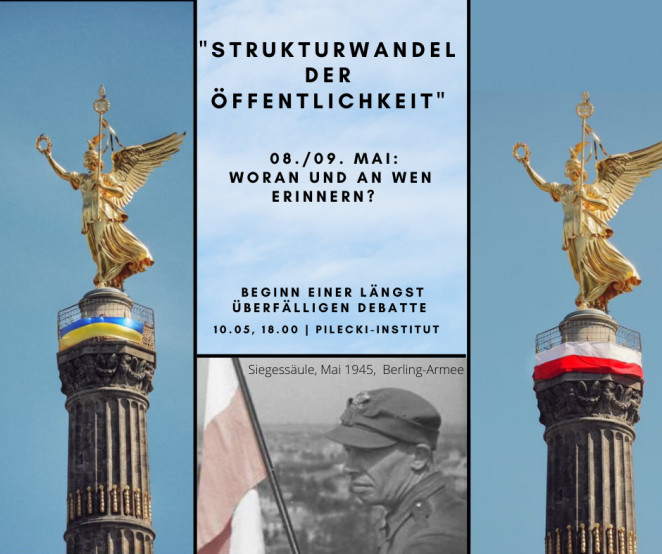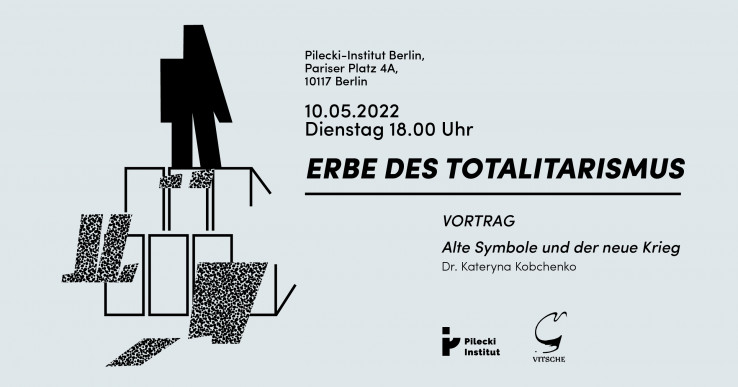08/09. Mai: Woran und an wen erinnern? - Instytut Pileckiego
08/09. Mai: Woran und an wen erinnern?
Unsere neue Veranstaltungsreihe "Legacy of Totalitarianism" soll eine längst überfällige Debatte anstoßen

"Strukturwandel der Öffentlichkeit
08/09. Mai: Woran und an wen erinnern?"
10.05, 18.00 | The Legacy of Totalitarianism, Dr. Kateryna Kobchenko | Anmeldung: events@pileckiinstitut.de
Morgen startet unsere neue Veranstaltungsreihe "The Legacy of Totalitarianism", mit der wir eine längst überfällige Debatte zur kollektiven Erinnerung im öffentlichen Raum anstoßen möchten. Ukrainer waren sowohl unter den Opfern des deutschen NS-Regimes als auch den Eroberern Berlins vertreten - eine Tatsache, die weithin wenig bekannt ist.
An den Gefechten rund um Berlin waren zudem 185.000 Polinnen und Polen beteiligt, über 10.000 kämpften direkt in der Stadt. Die Soldatinnen und Soldaten der Berling-Armee waren an der Eroberung und Befreiung Berlins maßgeblich beteiligt. Wir gedenken ihrer am heutigen Tage.
Wir sehen an der öffentlichen Debatte der letzten Tage, dass selektive und zu eng gefasste kollektive Erinnerung zu falschen Heuristiken führt und deswegen das Wesen des russischen Angriffskriegs immer noch viel zu häufig missverstanden wird.
Wir laden Sie herzlich dazu ein, mit uns über die Lücken des kollektiven Gedächtnisses in Berlin und Deutschland zu diskutieren und vor allem, wie man ihnen beikommen kann.
Mehr Infos zur ersten Veranstaltung in dieser Reihe:

“Soviet Tank-Monuments in Berlin: Old Symbols and the new War”
Lecture series: "The Legacy of Totalitarianism: Architecture"
10.05.2022, 18.00 | Pariser Platz 4A, 10117 Berlin | Register here: events@pileckiinstitut.de
No totalitarian regime can be established without keeping a monopoly on truth - yet in order to do so it has to absorb various elements of the national, social and cultural heritage of a given country. This in turn allows totalitarian regimes to make fully use of the force of myth. The Soviet War Memorial in Tiergarten and the two tanks from Charkiw standing on pedestals in front of it provide an interesting case-in-point: On the one hand traces of its totalitarian roots strike the eye immediately, but on the other hand the war memorial is undoubtedly steeped in history and real historic events.
This lectures addresses one of the central dilemmas at the heart of monumental architecture and an honest assessment of its contribution to the cityscape: How to shed light on the dark side of its establishment and unveiling, name the offender and occupier and develop a deep grasp of post-totalitarian understanding whilst treasuring the past and giving justice to all of its complexity.
Zobacz także
- Frohe Weihnachten!
News
Frohe Weihnachten!
Das Institut bleibt vom 22.12.2025 bis einschließlich 06.01.2026 geschlossen und ist ab dem 07.01.2026 wieder geöffnet.
- Richard Herzinger: Ein Patriot der Freiheit
News
Richard Herzinger: Ein Patriot der Freiheit
Gedenkrede und Fotos von Beisetzung
- Bekanntgabe
News
Bekanntgabe
Bekanntgabe des Ergebnisses des Auswahlverfahrens für die Leitung der Außenstelle des Pilecki-Institus
- Zum 86. Jahrestag der "Sonderaktion Krakau"
News
Zum 86. Jahrestag der "Sonderaktion Krakau"
Sie verkörpert das Wesen der deutschen Besatzung Polens: die Vernichtung der polnischen Bildungsschichten und damit der polnischen Identität. Zugleich erschließt sie universelle Lehren über die Handlungsmuster totalitärer Regime.
- Neuer Ukraine-Podcast!
News
Neuer Ukraine-Podcast!
OUT NOW! Folge 4: "Die Revolutionen von 1917-1921"
- Wir gratulieren Karl Schlögel
News
Wir gratulieren Karl Schlögel
...zum Friedenspreis des Deutschen Buchhandels!
- Nachruf für Richard Herzinger (1955–2025)
News
Nachruf für Richard Herzinger (1955–2025)
Lieber Herr Herzinger, Sie werden uns sehr, sehr fehlen – mit Ihrer herzlichen, zugleich direkten Art, Ihrem unendlichen enzyklopädischen Wissen, Ihrer moralischen Klarsicht und Ihren stets bereichernden Beiträgen in so vielen Bereichen.
- Heute geschlossen
News
Heute geschlossen
Aus betrieblichen Gründen bleibt das Institut am heutigen Samstag, den 25. Oktober, geschlossen.
- Auswahlverfahren für die Stelle des Leiters des PIlecki-Instituts in Berlin!
News
Auswahlverfahren für die Stelle des Leiters des PIlecki-Instituts in Berlin!
Alle wichtigen Infos
- Zum Tag der Deutschen Einheit
News
Zum Tag der Deutschen Einheit
Liebe Freunde, alles Gute zum 35. Jahrestag der Deutschen Einheit!
- BREAKING - OFFIZIELLE ERKLÄRUNG
News
BREAKING - OFFIZIELLE ERKLÄRUNG
Das Pilecki-Institut gibt bekannt, dass Hanna Radziejowska und Mateusz Fałkowski ihre Arbeit in der Berliner Niederlassung wieder aufnehmen.
- Karol Madaj ist neuer amtierender Direktor des Pilecki-Instituts.
News
Karol Madaj ist neuer amtierender Direktor des Pilecki-Instituts.
Die Kulturministerin Marta Cienkowska berief ihn heute in diese Funktion.